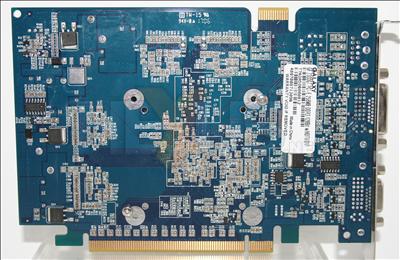Galaxy GeForce 7300 GT 256 GDDR3



Using nearly exactly the same PCB and cooler as its 7600 GS GDDR3, and with as much memory (256MiB), really the only thing differentiating the two to look at is the backplane. The 7300 GT GDDR3 carries DVI and VGA, as well as video output, rather than the dual DVI of the 7600 GS.
There's a G73 GPU underneath the Zalman cooler that both carry. Cooler-wise, the Zalman is pretty much silent. Only heard during testing when the workstation used to type this article was switched off, detecting whether the Zalman was even spinning was impossible over the rest of the noise in the room.
That's the idea, really. Features-wise, the 7300 GT GDDR3 doesn't get the SmartFlash and dual BIOS functionality of the 7600 GS, which is somewhat of a shame but understandable for the target market.
SLI support is present, should you wish to run two, and everything considered the Galaxy GeForce 7300 GT GDDR3 is pretty sweet on paper. It comes clocked at 500/700MHz. We'll let you ponder that for a second. Maybe you want to run off to NVIDIA's site and check the reference clocks. Yeah, that's right, the 350/350 clocks set by NVIDIA for the reference 7300 GT are blown out of the water.
It's somewhat rare to see a dual-slot cooler on a 7300 GT, but then this particular 7300 GT doesn't really have the same low-end aspirations as NVIDIA would like. Only lack of dual DVI stops this author wanting to slide it into the PC used to type these words, since I'd love a low-power, near-silent VGA board that doesn't get warm, especially since gaming performance (on paper) shouldn't be terrible. We'll test that soon.
Remember that this particular 7300 GT isn't a full G73 configuration, the BIOS turning off a vertex shader and a quad of fragment units, leaving the hardware with a 4/8/8 config (vertex/pixel/ROP), rather than 5/12/8 (or the 3/4/4 of the G72 that powers GeForce 7300 GS).
Bundle and presentation should be much the same as the 7600 GS, but we'll check and see, just to be sure.









